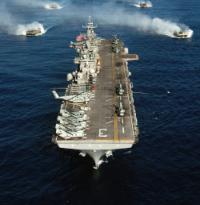The U.S.S. Kearsarge amphibious assault ship set sail from Norfolk, Va., in August, on a mission to provide free medical care to six Latin American countries. But five days into her four-month cruise, on Aug. 11, Kearsarge made an important detour, swinging within helicopter range of Miami to receive visitors. The roughly 20 people who clambered aboard from the hulking Marine Corps choppers represented a mix of U.S. military brass, civilian aid workers, local Miami elected officials and Spanish-language media.
"Our multinational team is dedicated to recommit and fortify our relationships in South America," Capt. Frank Ponds, ranking U.S. officer on Kearsarge, told the assembled VIPs in one of the 1,000-foot-long vessel's staterooms. He was specifically referring to the ship's current medical mission, but his words could also apply more generally to the July launch of the U.S. Fourth Fleet, a new headquarters for Latin American naval operations that is intended to boost U.S. military presence in what one analyst has called a traditionally "forgotten" part of the world. Kearsarge's cruise represented one of Fourth Fleet's first deployments.
Later, Ponds explained to the embarked reporters accompanying the vessel on her tour that ceremonies like the one on Aug. 11 were a key facet of Kearsarge's mission. Treating a few tens of thousands of patients in Latin America would not be enough: The Navy also needed to explain what it was doing, and why, to the hundreds of millions of people in the region who would not be receiving medical care. Ponds said this "strategic communications" was vital to "influencing generations to come."

